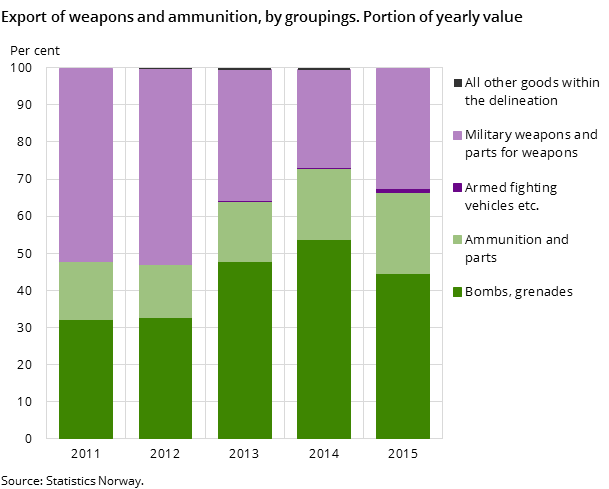Norwegian exports of weapons 2011-2015
Exports of arms rose in 2015
Published:
Norway exported weapons for NOK 2.4 billion in 2015, nearly NOK 600 million more than in the previous year. The product group “bombs, grenades, torpedoes etc." and "ammunition and parts" increased in particular. Norwegian exports of arms in 2015 were still less than in the peak years from 2008 to 2012 when export values totalled between NOK 2.5 and 3.1 billion.
- Series archive
- Exports of weapons
The underlying data in this article are based on customs export declarations and contain all military weapons except for warships and fighters. Further reading (link to various sources for figures for arms exports).
In 2015, exports of arms within the commodity group "bombs, grenades torpedoes etc." came to nearly NOK 1.1 billion. This is an increase of NOK 98 million compared to last year and is the highest export value recorded for this product group. The same applies to exports of goods within the group "ammunition and parts", with an export totalling NOK 523 million; about 50 per cent higher than the year before.
NATO member countries are the main recipients of Norwegian arms
As in previous years, the NATO member countries were the main recipients of Norwegian weapons, and bought to a value in excess of NOK 1.6 billion; around 70 per cent of the total export value. For the past 5 years, NATO member countries have received between 60 (2012) and 80 (2014) per cent of Norwegian military exports.
Due to armament agreements etc., exports to individual countries vary a lot from one year to another. The USA has for many years been the largest recipient, and imported Norwegian weapons worth NOK 855 million in 2015. NOK 293 million was for "ammunition and parts", which is an increase from NOK 34 million a year earlier. Poland was a large importer of Norwegian arms, as in previous years. Poland accounted for NOK 333 million, of which NOK 263 million concerned goods within the group "bombs, grenades, torpedoes etc.". In 2015, exports of military equipment to the Netherlands amounted to NOK 119 million. About two-thirds of the value was spent on "military weapons and parts of weapons."
Increased exports to non-NATO countries
Non-NATO countries imported Norwegian weapons for approx. NOK 776 million in 2015. This is about twice the value as in 2014, but still less than in 2012 when the export value to these countries were particularly high – NOK 1 billion1. Brazil was the largest importer in 2015, buying Norwegian arms for NOK 188 million, while Switzerland and Sweden imported military weapons for NOK 124 and just under NOK 97 million respectively.
With regard to countries in the Middle East, Norway exported weapons to several countries in the region in 2015. The Arab Emirates accounted for NOK 38 million and Kuwait for NOK 16.3 million. There were also some minor exports of arms to Qatar (NOK 641 000) and Saudi Arabia (NOK 58 000). Exports to these countries were for goods within the categories "ammunition and parts" and "military weapons and parts of weapons."
Norway - the tenth largest exporter of arms in 2014
According to newest data in Comtrade, the UN's statistical database for external trade, Norway was the world's tenth largest exporter of arms in 2014. This is a fall from position seven in 2013 (revised figures). Switzerland, Finland, The Czech Republic and Brazil exported more weapons in 2014 than Norway.
Total exports of weapons for all countries worldwide came to USD 12.7 billion. This is around USD 450 million less than in 2013. The figures referred to relate to the value of customs declared export of arms, munitions and tanks.
The Norwegian share of the world's arms exports has fallen gradually since the peak year of 2008 when Norway was the world's fourth largest arms exporter, and accounted for 5.4 per cent of the total export value. The USA is still the biggest exporter of military arms. US exports came to USD 5.4 billion in 2014, which is 43 per cent of the arms exports worldwide. The second major exporting country in 2014 was Italy, with Canada, Germany and South Korea following. These countries all accounted for between 5.8 and 3.6 per cent of the total military arms export market.
SIPRI, Stockholm International Peace Research Institute, calculates and ranks the international trade in arms on a broader basis. Newest report can be consulted from SIPRI’s web-site.
1 The figure were corrected at 10:14 am 15 January 2016.
Contact
-
Statistics Norway's Information Centre

